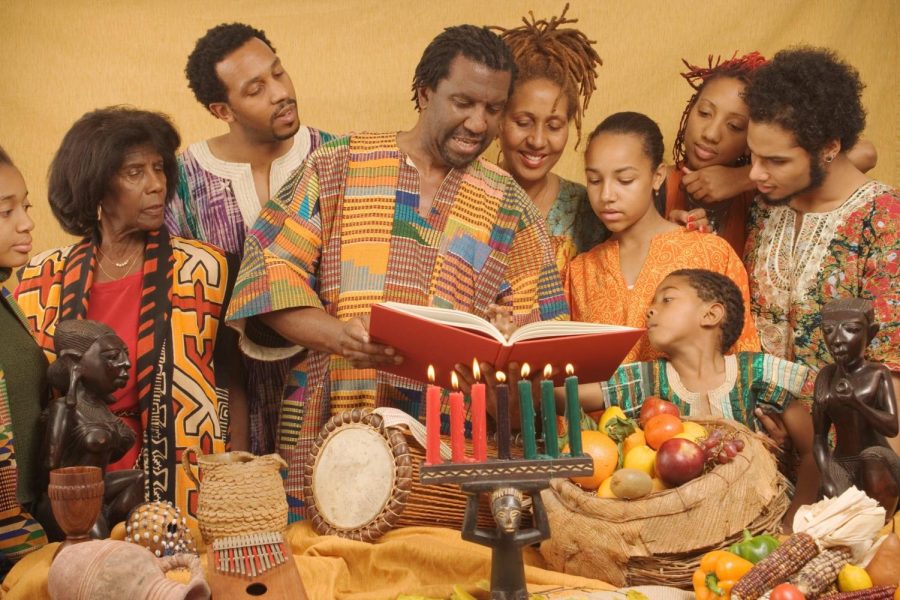How Kwanzaa is celebrated
December 26, 2019
Kwanzaa starts today!
Some you may be wondering: “What is Kwanzaa?” or “Where did it come from?”
Kwanzaa is a holiday started in 1966 by Dr. Maulana Karenga, professor and chairman of Black Studies at California State University. He was searching for a way to get African-Americans to come together after the Watts riots earlier that year. The holiday was founded based on many harvest festivals including those of the Ashanti and Zulu. Kwanzaa means “first fruits” in English. Each family celebrates Kwanzaa in its own way, but celebrations often include songs and dances, African drums, storytelling, poetry reading and a large traditional meal. Each of the seven nights people gather and discuss one of seven principles of Kwanzaa.
7 Principles
Unity: Umoja
To strive for and maintain unity in the family, community, nation and race.
Self-determination: Kujichagulia
To define ourselves, name ourselves, create for ourselves and speak for ourselves.
Collective Work and Responsibility: Ujima
To build and maintain our community together and make our brother’s and sister’s problems our problems and to solve them together.
Cooperative Economics: Ujamaa
To build and maintain our own stores, shops and other businesses and to profit from them together.
Purpose: Nia
To make our collective vocation the building and developing of our community in order to restore our people to their traditional greatness.
Creativity: Kuumba
To do always as much as we can, in the way we can, in order to leave our community more beautiful and beneficial than we inherited it.
Faith: Imani
To believe with all our heart in our people, our parents, our teachers, our leaders and the righteousness and victory of our struggle.
7 Symbols
Mazao: the crops
The crops symbolize work: the basis of the holiday. It represents the historical foundation for Kwanzaa, the gathering of the people that is patterned after African harvest festivals in which joy, sharing, unity and thanksgiving are the fruits of collective planning and work.
Mkeka: Place Mat
The mkeka, made from straw or cloth, comes directly from Africa and expresses history, culture and tradition. It symbolizes the historical and traditional foundation for African Americans to stand on and build their lives because today stands on their yesterdays, just as the other symbols stand on the mkeka.
Vibunzi: Ear of Corn
The stalk of corn represents fertility and symbolizes that through the reproduction of children, the future hopes of the family are brought to life. One ear is called vibunzi, and two or more ears are called mihindi. Each ear symbolizes a child in the family, and thus one ear is placed on the mkeka for each child in the family.
Mishumaa Saba: The Seven Candles
Candles are ceremonial objects with two primary purposes: to re-create symbolically the sun’s power and to provide light. The celebration of fire through candle burning is not limited to one particular group or country; it occurs everywhere. Mishumaa saba are the seven candles: three red, three green and one black. The black candle celebrates unity among the African American community.
Kinara: The Candleholder
The kinara symbolizes the ancestors, who were once earthbound; understand the problems of human life; and are willing to protect their progeny from danger, evil and mistakes. In African festivals the ancestors are remembered and honored. The mishumaa saba are placed in the kinara.
Kikombe Cha Umoja: The Unity Cup
The kikombe cha umoja is a special cup that is used to perform the libation (tambiko) ritual during the Karamu feast on the sixth day of Kwanzaa. In many African societies libation are poured for the living dead whose souls stay with the earth they tilled.
Zawadi: Gifts
When people celebrate Imani on the seventh day of Kwanzaa, they give meaningful zawadi (gifts) to encourage growth, self-determination, achievement, and success. They exchange the gifts with members of our immediate family, especially the children, to promote and reward accomplishments and commitments kept, as well as with their guests. Handmade gifts are encouraged to promote self-determination, purpose and creativity and to avoid the chaos of shopping during the December holiday season.









